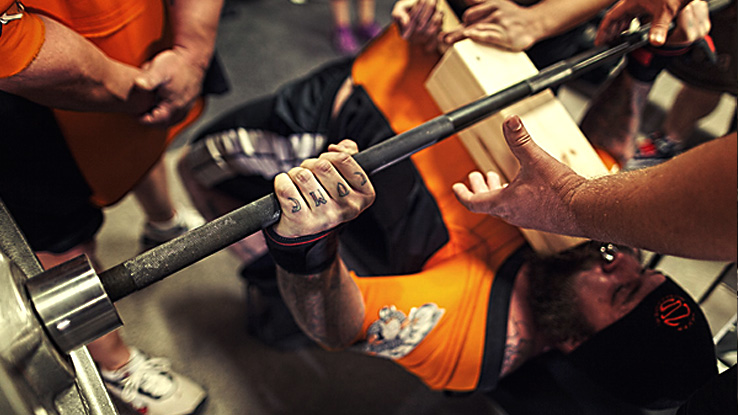Is your bench press stuck somewhere between 225 and 275 pounds? For most noncompetitive lifters, it is. The elusive 3-plate bench press stays out of reach, and as such, so does any number worth talking about.
A few years ago, I was one of those mediocre benchers. In fact, I gave up the bench press all together. I made all the usual excuses. I chalked it up to wanting better shoulder health, and that bench pressing wasn't a useful way to build any appreciable upper body mass. These days I'm calling BS on both.
Fast forward two years and I've put 100 pounds on my bench press. As I near the now elusive 4-plate bench press, I have some advice for anyone who wants to bench more.
Hone technique. Most people have a lot more strength capacity in them; they just lack the correct technique to display it. In order to dial in your form, you need to practice, a lot. Increasing your volume and/or exposure to a particular stress will also lead to improvement. Flat out, you need to do more to cause the body to recover from more, and in turn be able to do more.
The evidence to support this is alarmingly apparent. Why do so many gym goers have much better bench numbers than they do on any other lift? The evidence is clear: They've included a bench press variation in their routine every week since they stepped foot on a gym floor. It's really a no-brainer. Had they had a little more programming sense and some technique coaching, most men over the age of 25 would easily be able to bench press 3 plates, if they can't already.
While this isn't an article on technique, you should be pressing with a "powerlifting" style bench press. It'll save your shoulders, and it's the optimal way to handle heavier loads. Regardless of what you call yourself – bodybuilder, powerlifter, or fitness enthusiast – you should be benching like a powerlifter. In short, upper back tight and squeezed in, back arched, two points of contact with the bench (upper back and small of the lower back), medium grip, and feet on the floor. You get it.
But the main point is this: Almost every bench program I write includes at least two variations of the lift; some include up to four. The frequency with which you bench press is important as well. If possible, spread three to four pressing variations out over 2-3 training days when handling lower weights, and taper that down to 1-2 variations over 1-2 training days as you increase the weight.
There's no shortage of people trying to find ways to make things easier. All too often we turn to variations of the bench press that allow us to use more weight. In powerlifting circles that may mean more board pressing, more reverse band pressing, more chains, and a slew of other tricks to overload the press. They have their place, but they should be lower on the priority list.
In a more commercial gym setting, where these gadgets are less common, people will look to use phantom spotters ("It's all you, bro"), partial reps, and ridiculous techniques that give them optimal leverages to lift more weight. Think of those fools with their butt a foot off the pad, or those that bounce the bar off their sternum. They usually keep pressing the exact same loads every week, in the same style, for months or even years.
In order to press more often, you're going to need to find productive ways to bench press that actually take weight off the bar. By doing so you can challenge technique, challenge weak points, and in return improve in both areas while keeping stress at a manageable level so you can recover quickly.
Two effective ways to make the press harder: change the grip and change the tempo. From a grip standpoint, narrower improves wider, so I challenge you to work on more close-grip bench pressing.
From a tempo standpoint, work with pauses. Do more pausing of the bar on your chest for 1, 2, or even 3 seconds, and do likewise at different points of the concentric of the bench press (for instance, 2" above the chest and half way to lockout).
There's a lot of merit to training two crucial points in the press – off the chest and the lockout. I shy away from saying these are the two most common "sticking points" as any lifts missed at lockout are mainly a function of wasted energy coming out of the bottom. However, it's a safe bet that the most difficult point in any bench press will always be the bottom. That being said, if you have great strength in the top end, it can make up for a lackluster push off the bottom and possibly save the lift.
In order to train better power off the chest, use the pin press. Pin presses do a few great things for us. One, they give you a chance to dial in technique and understand the feel of "driving yourself into the bench and away from the bar." Next, they remove the stretch reflex from aiding in press with any stored up kinetic energy. Lastly, they minimize eccentric stress as the trainee can essentially drop the bar back to the pins in a controlled fashion. This minimal eccentric stress makes it another great way to add more exposure to pressing without adding too much stress.
To overload the muscles responsible for aiding in the top end portion of the press, use floor pressing. Floor pressing challenges us to press through most of the bench press range of motion (depending on how thick your torso is and how long your arms are) without benefitting from any leg drive. In many cases the inability to drive through the legs also forces you to use less weight, making it another viable option for repeated exposure without too much overall stress.

How do you link it all together? There are several ways to organize your training, but here's something you can put into action right away. It's a simple 4-week approach to bench press training that incorporates all the tips above.
This mini-program is to be done in place of your normal bench press exercises. You may continue to do lighter, higher-rep dumbbell presses on any of these days – just limit it to one day and one dumbbell pressing exercise.
Note: If you can only bench press twice a week, combine day 1 and 3. If you can only bench press once per week combine day 1 and 3, and scrap day 2 all together.
Week 1
- Day 1: Bench Press: 6x5 (30 Reps) @ 65% of 1RM
- Pause all reps on chest 1 second.
- Day 2: Floor Press: 4x6 @ 50%
- Pause elbows briefly on floor.
- Day 3: Pin Press: 10x1 @ 60%
- Set pins 2" off chest , rest 30-45 seconds between each rep.
Week 2
- Day 1: Bench Press: 5x5 (25 Reps) @ 70% of 1RM
- Pause first rep and last rep on chest for 2 seconds.
- Day 2: Floor Press: 3x6 @ 55%
- Pause elbows briefly on floor.
- Day 3: Pin Press: 8x1 @ 65%
- Set pins 2" off chest, rest 45-60 seconds between each rep.
Week 3
- Day 1: Bench Press: 5x4 (20 Reps) @ 75% of 1RM
- Pause first rep on chest for 3 seconds.
- Day 2: Floor Press: 4x4 @ 60%
- Pause elbows briefly on floor.
- Day 3: Pin Press: 6x1 @ 70%
- Set pins 2" off chest, rest 60-90 seconds between each rep.
Week 4
- Day 1: Bench Press: 4x4 (16 Reps) @ 80% of 1RM
- Pause first rep on chest for 2 seconds.
- Day 2: Floor Press: 3x4 @ 65%
- Pause elbows briefly on floor.
- Day 3: Pin Press: 4x1 @ 75%
- Set pins 2" off chest, rest 90-120 seconds between each rep.





